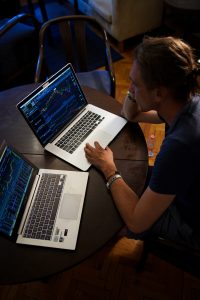Forex trading is a complex activity that requires a deep understanding of the market and the ability to quickly identify profitable opportunities. One of the most popular tools used by traders is a market scanner. A market scanner is a software program that helps traders identify potential trading opportunities by scanning the market for specific criteria. In this article, we will explore how to program a market scanner for forex.
Before we dive into the technical details of programming a market scanner, it is important to understand the basic principles behind the tool. A market scanner is designed to identify trading opportunities based on specific criteria such as price movements, volume, and technical indicators. The criteria used to identify opportunities may vary depending on the trader’s preferences and trading strategies. However, some common criteria used in forex market scanners include moving averages, support and resistance levels, and trend lines.
To program a market scanner for forex, you need to have a good understanding of programming languages such as Python, R, or C++. These programming languages are commonly used in financial markets and are well-suited for developing market scanners. Once you have selected a programming language, you can start building your market scanner.
The first step in programming a market scanner for forex is to define the criteria you want to use to identify trading opportunities. For example, you may want to identify trading opportunities based on the crossover of two moving averages. Once you have defined your criteria, you can start writing the code to scan the market for these conditions.
To scan the market, you need to access real-time data from the forex market. This data can be obtained through APIs provided by forex brokers or third-party data providers. Once you have access to the data, you can start writing the code to scan the market for the conditions you have defined.
One of the most important aspects of programming a market scanner is to ensure that it is efficient and fast. Forex markets move quickly, and traders need to be able to identify trading opportunities in real-time. Therefore, your market scanner needs to be able to scan the market quickly and efficiently.
To optimize the speed and efficiency of your market scanner, you can use techniques such as parallel processing and multithreading. These techniques allow you to split the scanning process into multiple threads, which can run simultaneously and reduce the time it takes to scan the market.
Another important aspect of programming a market scanner is to ensure that it is accurate and reliable. To achieve this, you need to test your market scanner thoroughly using historical data. Historical data can be obtained from forex brokers or third-party data providers. By testing your market scanner with historical data, you can identify any bugs or errors in your code and refine your criteria to improve its accuracy.
In conclusion, programming a market scanner for forex is a complex task that requires a deep understanding of programming languages, market dynamics, and trading strategies. However, with the right tools and techniques, you can develop a powerful and efficient market scanner that can help you identify profitable trading opportunities in real-time. Remember to define your criteria carefully, optimize your code for speed and efficiency, and test your market scanner thoroughly to ensure its accuracy and reliability.






